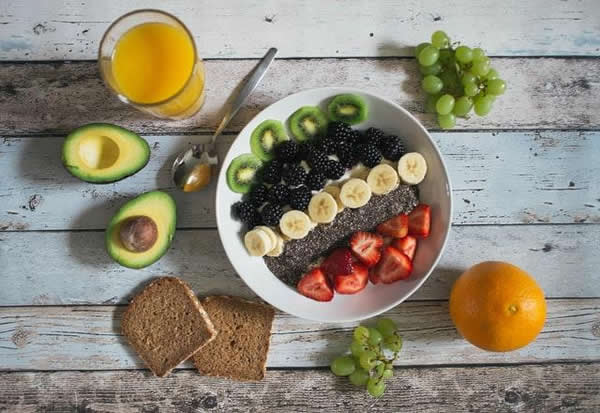
It’s that time of year when many of us are considering a diet change as a New Year’s Resolution. But with all of the wildly different diets out there, don’t let your new diet affect your pelvic floor health negatively.
Avoid Constipation
Constipation can contribute to pelvic pain, risk of prolapse, back pain, and pain with sex, among other issues.
As we’ve written about on this blog before, managing constipation is one of the cornerstones for maintaining pelvic health, especially if you suffer from pelvic pain, prolapse, or pain with sex. Constipation will lead to storage of old stool in the colon, which can contribute to pelvic, abdominal, and back pain. This added pressure can lead to pelvic floor tension and contribute to issues like pelvic pain and pelvic floor spasms. Last, but not least, constipation leads to straining on the toilet, which greatly increases your risk for issues like pelvic organ prolapse (read more about prolapse).
To avoid constipation, try the following tips:
- Exercise. Motion is lotion! Approximately 30 minutes of daily cardiovascular activity can help improve motility of intestinal waste.
- Massage your belly. Abdominal lymphatic massage– a self-care technique we teach at the clinic, it is used to decrease the edema and bloat in the belly caused by IBS issues, constipation, loose stools, and pelvic pain.
- Drink water! Your GI system needs water to keep things moving. Drink approximately 64 oz daily.
- Take care of your body tissues. Stretch daily, use a foam roller to release tight spots and mobilize connective tissue, get monthly massages.
Eat Enough Fiber
What is fiber?
-
Fiber we get from our diet comes from plant cells we ingest which cannot be broken down by enzymes in the human digestive tract. The fiber helps us form healthy and easy to pass stools, which contribute to pelvic health. In fact, in a 2008 study by Shariati, Maceda, and Hale, they found that 1 cup of high fiber cereal daily helped study participants improve their pelvic floor function and bowel regularity. For stools that are easy to pass and healthy for the pelvic floor, it is important to have both types of: water-soluble and water insoluble.
-
Soluble Fiber
Water-soluble fibers absorb water during digestion and help increase stool bulk and can help “gel” soft or watery stools. Soluble fiber may also decrease blood cholesterol levels. Find soluble in fruits (apples, peaches, pears), vegetables, legumes (dry beans, lentils and peas), barley, oats and oat bran.
-
Insoluble Fiber
Water-insoluble fibers remain unchanged during digestion and help movement and motility of your stool through the GI tract. Find insoluble fiber in the edible peel or seeds of fruits and vegetables, in whole grain products (such as whole-wheat bread, pasta and crackers), bulgur wheat, stone ground corn meal, cereals, bran, rolled oats, buckwheat and brown rice.
How much fiber should you be eating?
The American Heart Association recommends a total dietary fiber intake of 25 to 30 grams a day from food, not supplements. The average adult in the United States has about 15 grams of fiber a day. That’s about half the recommended amount.
Some Tips To Increase Dietary Fiber
- High Fiber Cereal— In a 2008 study by Shariati, Maceda, and Hale, they found that 1 cup of high fiber cereal daily was enough to help study participants improve their pelvic floor function and bowel regularity.
- Whole Grains- Try to include at least one serving of whole grain in every meal. Use whole-wheat flour when possible in your cooking and baking. Cook with brown rice instead of white rice. If the switch is hard to make, start by mixing them together.
- Beans- Add kidney beans, garbanzos or other bean varieties to your salads or soups. Dip veggies into hummus or a white bean dip.
- Fruits and Veggies – Try adding a green smoothie to your diet to increase your intake of fruits and veggies : 1 ½ c. spinach, kale or dark greens; 1 c almond milk; 3 TBS ground flax seed; 1 banana; ½ cup or frozen berries.
And as always, if you need any help with your pelvic floor, please don’t hesitate to call us and schedule an appointment today.
Resources
Shariati A, Maceda JS, Hale DS. High-fiber diet for treatment of constipation in women with pelvic floor disorders. Obstet Gynecol. 2008 Apr;111(4):908-13. doi: 10.1097/01.AOG.0000308660.48204.7f. PMID: 18378750.
Arya LA, Novi JM, Shaunik A, Morgan MA, Bradley CS. Pelvic organ prolapse, constipation, and dietary fiber intake in women: a case-control study. Am J Obstet Gynecol. 2005 May;192(5):1687-91. doi: 10.1016/j.ajog.2004.11.032. PMID: 15902178.
UCSF Health: Increasing Fiber Intake (2020).
https://www.ucsfhealth.org/education/increasing-fiber-intake#:~:text=Total%20dietary%20fiber%20intake%20should,about%20half%20the%20recommended%20amount.
